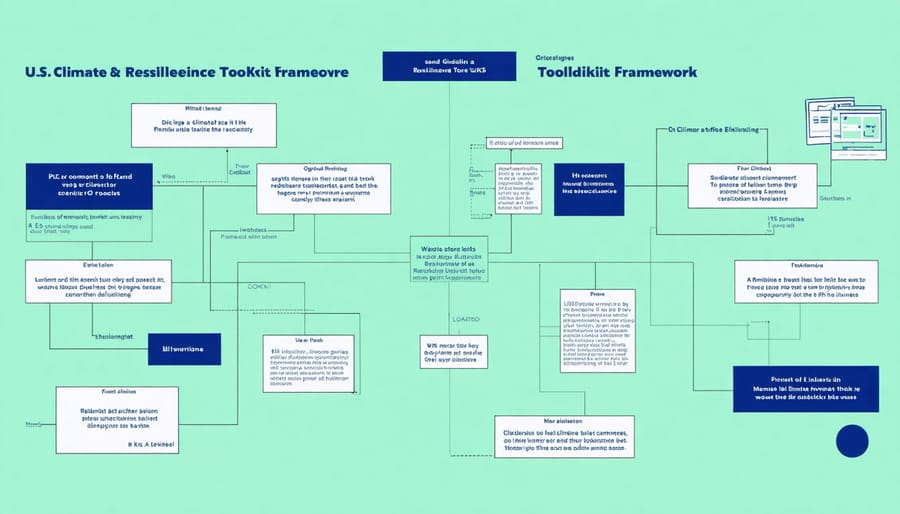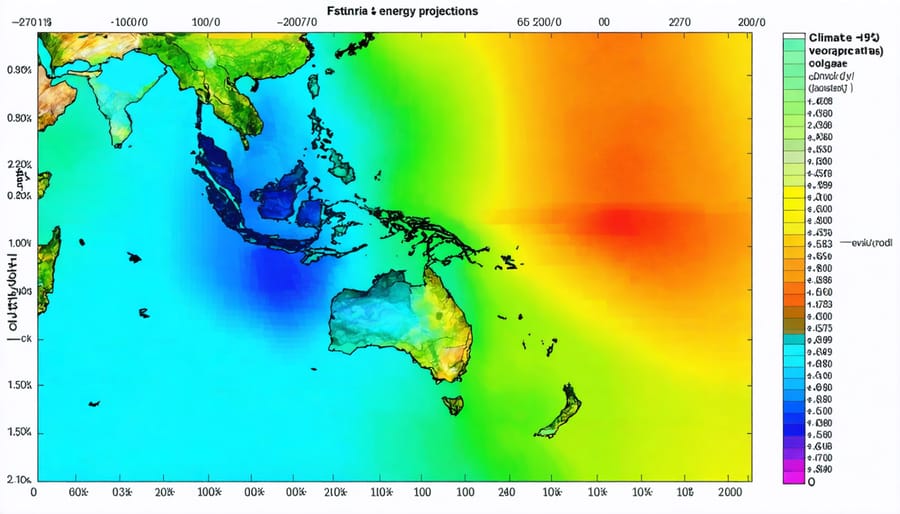How the U.S. Climate Resilience Toolkit Transforms Energy Storage Systems

Transform your climate adaptation planning with the U.S. Climate Resilience Toolkit’s comprehensive framework for implementing robust energy resilience strategies. This federally-backed platform delivers data-driven solutions, interactive assessment tools, and region-specific guidance for European organizations navigating climate challenges.
The toolkit’s Steps to Resilience methodology revolutionizes how businesses and communities approach climate risk management. By integrating real-time climate data, vulnerability assessments, and adaptation strategies, decision-makers can develop actionable plans that protect critical infrastructure and ensure operational continuity.
European stakeholders benefit from the toolkit’s universal application framework, which aligns seamlessly with EU climate directives while offering customizable solutions for local contexts. The platform’s emphasis on science-based decision-making and collaborative planning provides an essential bridge between North American expertise and European implementation needs.
Whether addressing flood risks, heat stress, or energy system vulnerabilities, the toolkit’s systematic approach enables organizations to build resilience through informed, strategic action. Its integration of economic analysis tools helps stakeholders prioritize investments and demonstrate clear returns on adaptation measures.
Understanding the U.S. Climate Resilience Toolkit Framework

Key Components for Energy Storage Assessment
The U.S. Climate Resilience Toolkit provides essential components for evaluating and implementing energy storage systems, adaptable for European contexts. The assessment framework encompasses three crucial elements: technical feasibility analysis, resilience metrics, and integration capabilities.
The technical feasibility component guides users through storage capacity requirements, system efficiency evaluations, and technology selection criteria. This includes detailed assessment tools for battery systems, thermal storage, and emerging storage technologies, helping stakeholders make informed decisions based on their specific needs.
For resilience evaluation, the toolkit offers comprehensive metrics focusing on system reliability during extreme weather events, grid stability enhancement, and backup power capabilities. These metrics are particularly relevant for European regions experiencing increasing climate-related challenges.
The integration assessment tools examine compatibility with existing infrastructure, grid connection requirements, and potential scaling opportunities. This component includes interactive modeling tools that simulate various scenarios, helping users understand how different storage solutions might perform under diverse conditions.
The toolkit also provides cost-benefit analysis templates, environmental impact assessments, and regulatory compliance guidelines, ensuring a holistic approach to energy storage implementation while maintaining alignment with European standards and sustainability goals.
Risk Assessment Tools for Storage Infrastructure
The U.S. Climate Resilience Toolkit offers sophisticated risk assessment tools specifically designed for evaluating storage infrastructure vulnerabilities. These tools enable European stakeholders to conduct comprehensive analyses of their energy storage facilities against various climate-related threats.
At the core of the assessment framework is the Climate Explorer tool, which provides detailed climate projections and potential impact scenarios for specific geographical locations. This allows facility managers to evaluate risks such as extreme temperature fluctuations, flooding potential, and severe weather events that could affect storage systems.
The toolkit’s Storage Infrastructure Vulnerability Index (SIVI) helps quantify risk levels across different storage components, from battery installations to thermal storage units. Users can input facility-specific data to generate detailed risk profiles and prioritize adaptation measures accordingly.
Additionally, the toolkit features interactive mapping capabilities that overlay climate risk data with existing storage infrastructure locations. This visualization helps identify potential vulnerabilities and supports strategic planning for future storage deployments. The assessment process includes both immediate risk factors and long-term climate change considerations, ensuring comprehensive evaluation for sustainable storage solutions.
Implementing Climate-Resilient Storage Solutions

Temperature Resilience Strategies
Temperature fluctuations pose significant challenges for energy storage systems, requiring robust strategies to maintain optimal performance. The U.S. Climate Resilience Toolkit offers comprehensive guidance for developing climate-resilient power networks that can withstand extreme temperature variations.
Key protective measures include implementing advanced thermal management systems, such as phase-change materials and active cooling solutions. These systems help maintain stable operating temperatures within storage units, particularly crucial for battery-based solutions where performance and longevity are temperature-dependent.
For regions experiencing extreme heat, the toolkit recommends incorporating reflective surfaces and enhanced ventilation systems. Strategic placement of storage units in naturally cooler locations, combined with proper insulation, can significantly reduce cooling requirements. In colder climates, focus shifts to preventing freezing and maintaining minimum operating temperatures through targeted heating elements and thermal blankets.
Monitoring systems play a vital role in temperature resilience. Smart sensors and automated controls can detect temperature anomalies early, triggering protective measures before critical thresholds are reached. This proactive approach helps prevent system damage and maintains consistent energy availability.
The toolkit emphasizes the importance of redundancy in temperature control systems, especially for critical infrastructure. This includes backup cooling systems and emergency power supplies dedicated to maintaining optimal storage conditions. Regular maintenance schedules, including thermal imaging inspections and performance monitoring, ensure these protective measures remain effective throughout the system’s lifecycle.
These strategies align with European climate adaptation goals while providing practical solutions for maintaining reliable energy storage capabilities across diverse temperature conditions.
Flood and Storm Protection Measures
Protecting energy storage systems from floods and severe storms requires a comprehensive approach to infrastructure design and implementation. The U.S. Climate Resilience Toolkit provides detailed guidelines for establishing robust power security measures that can withstand extreme weather events.
Key protective measures include elevating critical equipment above projected flood levels, implementing waterproof enclosures for ground-level components, and installing proper drainage systems around storage facilities. The toolkit recommends maintaining a minimum elevation of 1 meter above the highest recorded flood level for all essential equipment.
Storm protection strategies focus on reinforced housing structures, advanced lightning protection systems, and redundant power management controls. Facilities should incorporate impact-resistant materials for equipment enclosures and implement robust anchoring systems designed to withstand high wind speeds of up to 160 km/h.
The toolkit emphasizes the importance of regular maintenance schedules and emergency response protocols. This includes installing early warning systems, implementing remote monitoring capabilities, and establishing clear evacuation procedures for maintenance personnel. Regular testing of backup systems and weatherproofing measures ensures continued reliability during severe weather events.
For European implementations, these guidelines can be adapted to align with local building codes and climate patterns. Special consideration should be given to regional weather variations and specific environmental challenges, such as coastal flooding or alpine conditions. The toolkit’s recommendations can be integrated with existing European standards to create comprehensive protection strategies that ensure long-term system resilience.
European Applications and Adaptations
Regional Climate Considerations
Europe faces distinct climate challenges that require tailored resilience strategies. From the Mediterranean’s increasing heat waves to Northern Europe’s flooding risks, each region demands specific adaptation approaches. The U.S. Climate Resilience Toolkit has proven valuable for European energy infrastructure protection, particularly in coastal areas where rising sea levels threaten critical installations.
Key regional considerations include the Alpine region’s vulnerability to permafrost thaw, affecting energy transmission infrastructure, and the increasing frequency of extreme weather events in Central Europe impacting solar and wind energy generation. Mediterranean countries must adapt to prolonged drought periods, which affect hydroelectric power production and cooling systems for conventional power plants.
The toolkit’s adaptation strategies have been successfully modified for European contexts, incorporating local building codes, environmental regulations, and energy market structures. Notable implementations include fortifying North Sea wind farms against increasing storm intensity and protecting Mediterranean solar installations from extreme heat degradation.
Successful European adaptations often combine the toolkit’s framework with EU climate initiatives, creating comprehensive resilience plans that address both immediate vulnerabilities and long-term sustainability goals. This integrated approach helps ensure that climate adaptation measures align with European green energy targets while maintaining grid reliability and operational efficiency.
Integration with EU Energy Standards
The U.S. Climate Resilience Toolkit has been strategically aligned with European energy standards to facilitate seamless implementation across international borders. This integration focuses particularly on the EU’s Energy Performance of Buildings Directive (EPBD) and the Renewable Energy Directive (RED II), ensuring that toolkit recommendations complement European sustainability goals.
Key harmonization elements include energy efficiency metrics that parallel EU standards, allowing European stakeholders to utilize the toolkit’s resources while maintaining compliance with local regulations. The toolkit’s assessment tools have been calibrated to incorporate European energy measurement units and performance indicators, making it straightforward for EU-based organizations to evaluate their climate resilience strategies.
The adaptation guidelines within the toolkit now feature specific considerations for European climate zones and energy infrastructure, addressing unique regional challenges such as district heating systems and renewable energy integration requirements. This alignment extends to carbon reduction targets, ensuring that implementations based on toolkit recommendations contribute to achieving the EU’s 2030 climate and energy framework goals.
For European businesses and institutions, this integration means they can confidently use the toolkit’s resources while maintaining adherence to EU regulations. The toolkit’s recommendations for energy storage solutions and grid resilience strategies have been specifically reviewed to ensure compatibility with European grid codes and energy market structures, facilitating smoother adoption of climate-resilient practices across the continent.
Future-Proofing Energy Storage Systems
Monitoring and Maintenance Protocols
The U.S. Climate Resilience Toolkit emphasizes systematic monitoring and maintenance as crucial components for long-term success. Regular assessment protocols typically include quarterly reviews of climate data trends, annual evaluations of implemented resilience measures, and continuous tracking of system performance metrics.
For European organizations adopting these protocols, the toolkit recommends establishing a dedicated monitoring team responsible for data collection, analysis, and reporting. This team should conduct monthly checks of early warning systems, verify the accuracy of climate sensors, and maintain detailed documentation of all observations and interventions.
Maintenance requirements focus on three key areas: infrastructure integrity, system functionality, and response capability. Organizations should schedule bi-annual comprehensive assessments of physical infrastructure, including protective barriers and drainage systems. System functionality checks should occur monthly, ensuring all monitoring equipment and communication networks operate efficiently.
The toolkit suggests implementing a digital maintenance management system to track scheduled maintenance, document repairs, and forecast potential issues. This approach allows organizations to maintain optimal performance while adapting to changing climate conditions.
For maximum effectiveness, European entities should integrate these protocols with existing EU environmental monitoring standards, creating a harmonized approach that satisfies both regional requirements and international best practices. Regular staff training and updates to emergency response procedures complete the maintenance framework, ensuring sustained climate resilience.
Adaptation Planning for Future Climate Scenarios
The U.S. Climate Resilience Toolkit emphasizes proactive adaptation planning as a crucial step in building resilient energy storage systems. This approach involves analyzing multiple climate scenarios and their potential impacts on storage infrastructure over different time horizons. By evaluating various climate projections, stakeholders can develop robust strategies that account for uncertainties in future conditions.
Key elements of adaptation planning include assessing temperature extremes, precipitation patterns, and severe weather events that could affect storage system performance. For instance, rising temperatures may impact battery efficiency and longevity, while increased storm frequency could threaten physical infrastructure. The toolkit provides resources to help organizations model these scenarios and identify appropriate adaptation measures.
Successful adaptation strategies often incorporate flexible design elements that allow for system modifications as climate conditions evolve. This might include implementing modular storage solutions, establishing redundant systems, or incorporating climate-resistant materials in construction. The toolkit also guides users through the process of prioritizing adaptation actions based on cost-effectiveness, implementation feasibility, and potential risk reduction.
Organizations are encouraged to regularly review and update their adaptation plans as new climate data becomes available. This iterative approach ensures that storage systems remain resilient and effective despite changing environmental conditions. The toolkit’s resources support continuous improvement in adaptation strategies, helping stakeholders maintain optimal system performance while preparing for future challenges.

The U.S. Climate Resilience Toolkit offers invaluable insights for European stakeholders looking to enhance their energy storage resilience. By adopting these proven strategies and tools, organizations can significantly improve their preparedness for climate-related challenges while optimizing their energy systems for long-term sustainability.
Key implementation steps include conducting thorough vulnerability assessments, developing comprehensive storage solutions that account for local climate projections, and establishing robust monitoring systems. European businesses and homeowners should focus on integrating these resilience measures with existing renewable energy infrastructure, particularly solar installations, to create a more robust and adaptive energy ecosystem.
Success in implementing resilient storage solutions requires a multi-faceted approach: investing in appropriate technology, developing clear operational protocols, and maintaining regular system evaluations. Organizations should prioritize flexibility in their storage systems, allowing for adjustments as climate conditions and energy needs evolve.
Moving forward, stakeholders should leverage local expertise while drawing upon the toolkit’s resources to create customized solutions. Regular updates to resilience strategies, based on performance data and changing climate patterns, will ensure long-term effectiveness. By embracing these practices, European entities can build more resilient energy storage systems that support sustainable operations while protecting against climate-related disruptions.
Remember that resilience planning is an ongoing process rather than a one-time implementation. Continuous improvement and adaptation will be key to maintaining effective energy storage solutions in our changing climate.
Leave a Reply